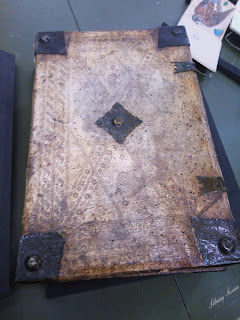On the 8th May I went to the CILIP
headquarters to hear my colleague Monique Ritchie and Andria McGrath, from
Kings College, and David Buckley talk about their positions (Research
Librarian, Research Information
Specialist, and Liaison Officer for Any Book Library
Services respectively) and how they
support academics in their research. I arrived early, and after some
considerable confusion as to what room the event was in, and having walked in
on two separate meetings (one was a roundtable discussion that I have to admit
I’m glad I wasn’t involved in; it appeared quite heated...) and walking around
the labyrinthine CILIP's corridors for some time, I arrived, still punctually,
for the meeting and sat down with a coffee and biscuit, courtesy of David Buckley.
David Buckley was the first to speak, and
humorously too, about his company: Any Book Library Services. The company
started in Greenwich and has since moved to Leicester where they are now based.
They pick up books from libraries and sell them, splitting the money between
the library and themselves. It sounded very interesting and I’m definitely more
positive about giving books to them to sell; to pump the money back into the
library as well as David’s company is surely better than hiring a skip to dump
them in unloving. (And, of course, I feel compelled to support a fellow
Buckley!) David's company collect
the books free of charge and 100% of profits are given to the library if the
book sells on the first day of being uploaded to all of the usual suspects
online (Amazon, Abe (also now owned by Amazon), Libris etc.). If it sells after
that, the money given to the library is on a daily sliding scale; 1st
day 100%, 2nd day 99%, and so on. David seems passionate about his company and it’s certainly
an interesting and seemingly profitable business model for both libraries and
the company itself, but I have to admit I’m not entirely sure how it makes
enough money, considering the competition for selling books online and the
percentages Amazon, and the like, take from sellers.
Next up was Andria who discussed the importance of working with IT and
research management as well as supporting academics. Andria highlighted the
importance of providing training that is designed for supporting the
researchers, however designing this training it seems is only half of the work;
getting people to attend being the other half. Together with providing the
teaching, Andria mentioned, the key to success is having very solid
relationships with the institution, such as a good working relationship with
the Graduate School in order to publicize and get people through the training
room door. Along with providing training, another key skill is a willingness to
professionally develop. Andria attended a course in Leiden, which, along with
an amazing trip, helped her to fulfill her role to her full potential.
Obviously this is not something that every institution is willing to pay for,
especially in a time of falling student numbers and smaller budgets, but
attending free events and training is something that is available, and well
worthwhile.
The third
Speaker, Monique Ritchie, Research Librarian at Brunel University, spoke about
her new post supporting researchers and the Research Data Management Project.
The key skills that Monique brought attention to are:
·
Flexibility and
adaptability
·
Prioritizing
·
Diplomacy
·
Sense of adventure
·
Thinking strategically
·
Networking
Networking is something that has always sent a shiver down my spine, and
many other people’s as well, but from the events that I have attended that have
included that twenty minutes for “coffee, tea and (yes! the dreaded) chat”,
that very twenty minutes has often been for me the most memorable. I’ve met
some very interesting people and even stayed in touch with some. Other skills
Monique drew our attention to are those that many other library roles require
as well; most people it seems must be flexible with the ability to move around
the institution, but with such a heavy workload for librarians supporting
researchers, the skill of prioritization certainly seemed like a must. Other
skills at first seemed more aligned with Parliament than libraries, such as
diplomacy and strategy, but Monique soon explained that she often had to
justify what she was doing and fight her corner. The research librarian has to
stay up to date and even determine in advance what the needs of the researcher
will be.
Supporting researchers seems to be a fluid role that constantly changes
with the developing needs of researchers themselves, the publishing world, and
changing academic practices. Both
speakers were incredibly enthusiastic towards their professional lives and
appeared to relish the dynamic positions they held, and the opportunities for
learning and developing they offered.
Monique's slides are available here: http://www.slideshare.net/CoFHELASEC/arlg-supporting-researchers
Andria's slides are available here: http://www.slideshare.net/CoFHELASEC/library-researchsupportpartnerships



